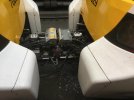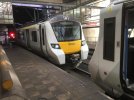Nicholas Lewis
Established Member
Excellent article. It should be emailed to ALL MPs on a station served by a Thameslink service and tell them to get onto the DfT about preventing this (it has enough issues it can't control so needs to prevent the ones in its control) as well as putting in place an adequate contingency plan when the core has issues. The railway can't hide behind suppressed covid demand anymore (although being a Monday it would have been lower than later days in the week) as one of the pictures in this article shows the amount of people that had to be evacuated from one of the stranded trains.Just did a write up on the pan-demotion that ensued in Black Friars Lane! That was at least £13,000 down the pan, smashing pantographs to bits ain't cheap, not to mention the fall out from the incident which must have been extremely costly.
Thameslink overextends itself
Yes very poor when they have the crew from the 9R/9J's (4tph) that they couldn't even sustain a half hourly service. Mind you as you then had to go forward on a 4car 377 from/to Redhill why wasn't it running to E.Croydon or really London Bridge like they do at weekend for planned closures. The 9R/9J service group should default to a L.Bdge to Horsham all stations 2TPH in this situtaion.They put in Redhill to Horsham shuttles which worked well for the first two hours but then fell apart and didn't recover through to end of service. Hopefully the Bognor trains stopped additionally although that's hit and miss in my experience. I'd never risk waiting at Littlehaven during disruption.


